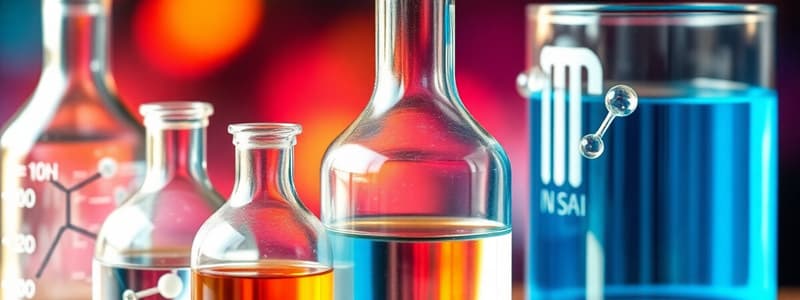Podcast
Questions and Answers
Explain how the properties of a homogeneous mixture differ from those of a heterogeneous mixture, providing an example of each.
Explain how the properties of a homogeneous mixture differ from those of a heterogeneous mixture, providing an example of each.
Homogeneous mixtures have uniform composition throughout, like saltwater. Heterogeneous mixtures do not have uniform composition, like sand and water.
Describe how the atomic number and mass number of an atom are related, and explain what isotopes are.
Describe how the atomic number and mass number of an atom are related, and explain what isotopes are.
The atomic number is the number of protons, defining the element. The mass number is the sum of protons and neutrons. Isotopes are atoms of the same element with different numbers of neutrons.
Explain, in terms of electron transfer or sharing, the fundamental difference between ionic and covalent bonds.
Explain, in terms of electron transfer or sharing, the fundamental difference between ionic and covalent bonds.
Ionic bonds involve the transfer of electrons between atoms, creating ions. Covalent bonds involve the sharing of electrons between atoms.
If a balloon is filled with 5 moles of helium gas at standard temperature and pressure (STP), what volume will the balloon occupy? (Assume ideal gas behavior, where 1 mole of any gas occupies 22.4 L at STP)
If a balloon is filled with 5 moles of helium gas at standard temperature and pressure (STP), what volume will the balloon occupy? (Assume ideal gas behavior, where 1 mole of any gas occupies 22.4 L at STP)
Describe the relationship between reactants, products, and a balanced chemical equation. Why is it important for chemical equations to be balanced?
Describe the relationship between reactants, products, and a balanced chemical equation. Why is it important for chemical equations to be balanced?
Explain the concept of a limiting reactant in a chemical reaction and describe its effect on the amount of product formed.
Explain the concept of a limiting reactant in a chemical reaction and describe its effect on the amount of product formed.
How does the periodic table organize elements, and what is the significance of elements within the same group (vertical column)?
How does the periodic table organize elements, and what is the significance of elements within the same group (vertical column)?
What is molarity, and how is it used to express the concentration of a solution? Give the equation for calculating molarity.
What is molarity, and how is it used to express the concentration of a solution? Give the equation for calculating molarity.
Explain the relationship between pH, acids, and bases. How does pH relate to the concentration of hydrogen ions (H+) in a solution?
Explain the relationship between pH, acids, and bases. How does pH relate to the concentration of hydrogen ions (H+) in a solution?
State Le Chatelier's principle and provide an example of how a change in temperature can affect a system at chemical equilibrium.
State Le Chatelier's principle and provide an example of how a change in temperature can affect a system at chemical equilibrium.
Flashcards
What is matter?
What is matter?
Anything that has mass and takes up space; exists as solid, liquid, gas or plasma and can be a pure substance or mixture.
What are pure substances?
What are pure substances?
Substances with a fixed composition and distinct properties; can be elements or compounds.
What are elements?
What are elements?
Substances that cannot be broken down into simpler substances by chemical means.
What are compounds?
What are compounds?
Signup and view all the flashcards
What are mixtures?
What are mixtures?
Signup and view all the flashcards
What are physical properties?
What are physical properties?
Signup and view all the flashcards
What are chemical properties?
What are chemical properties?
Signup and view all the flashcards
What are intensive properties?
What are intensive properties?
Signup and view all the flashcards
What are extensive properties?
What are extensive properties?
Signup and view all the flashcards
What is the limiting reactant?
What is the limiting reactant?
Signup and view all the flashcards
Study Notes
The provided text does not contain any new information and is identical to the original, thus no updates are needed
Studying That Suits You
Use AI to generate personalized quizzes and flashcards to suit your learning preferences.




